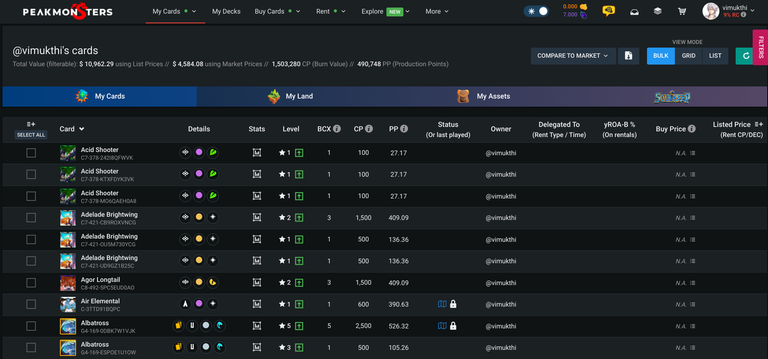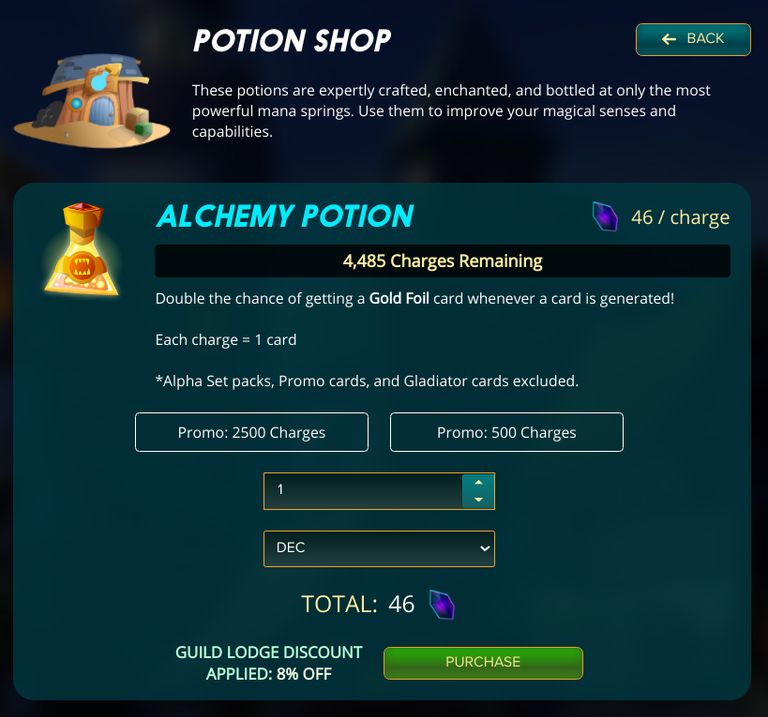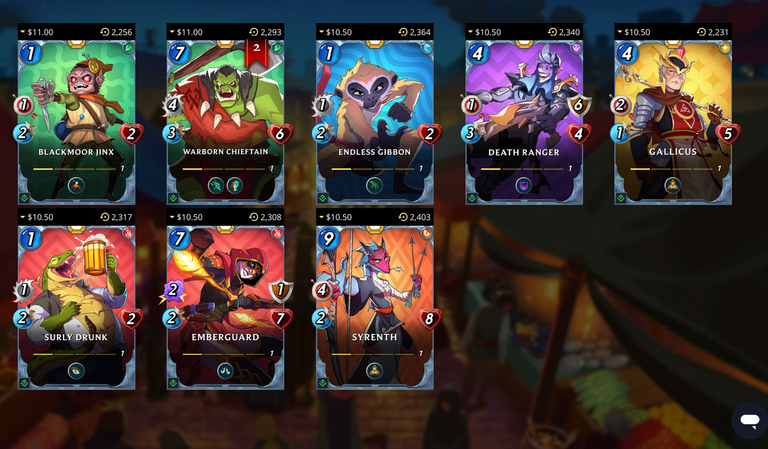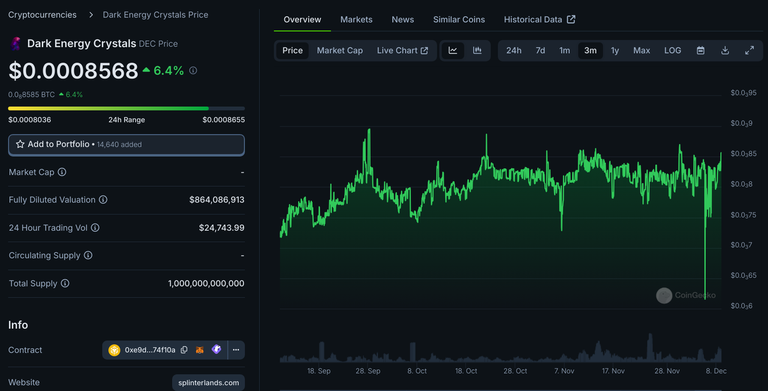Calculating The Dollar Value of Glint
Unlike the traditional multiplayer games, @splinterlands and other true Web 3 games allow users to convert their gameplay earnings into what users can use to pay their bills. This is a democratization of E-Sport industry and formalization of the various third party marketplaces where gamers could trade their game assets (usually while breaking Terms of Service). Some Rewards of @splinterlands are cryptocurrencies (eg: SPS) and others are NFTs. Then there are Soulbound Rewards such as Glint.
If you are making a financial investment into a game, it is ideal that you are familiar with the monetary value of what you are receiving as gameplay rewards. Cryptocurrencies and NFT can be easily valued by a simple look at the market. Some NFTs with low supply may not have their listing prices accurately represent how the market value them. For this reason, do not be surprised to see a single Card get valued at six or seven figures. The values you see on @peakmonsters can be skewed by these outliers.

Converting Reward Shop Values to Fiat
The easy way to do this is to find an item that can be bought with DEC (1,000 DEC is soft pegged to $1) and find the Glint cost of the item. It does not work for Energy because the Energy cost change based on the current League of the player.

The next place to look for is the Potion Shop. A quick look around the prices give a clear valuation for Glint at 0.5 DEC per Glint. Looking around the Reward Shop in the game will also reveal that 1 Glint can be valued the same as 1 MERIT for the first Batch of MERIT purchase. The price for each batch goes up by 50%.


Most players I know do not have to buy Potions because they already get them form Reward Chests. Another factor to consider is that potions themselves are Soulbound and cannot even be traded in any capacity. Glint must be valued based on items that can be sold for fiat. This brings us to the various Rarity Draws for the Cards.
Rarity Draw Prices

| Rarity | Regular Foil | Gold Foil | Multiplier |
|---|---|---|---|
| Common | 150 | 3,500 | 23.33 |
| Rare | 750 | 15,000 | 20 |
| Epic | 7,500 | 125,000 | 16.66 |
| Legendary | 35,000 | 600,000 | 17.14 |
As you can see, Gold foil adds another dimension of a multiplier for the calculation and these Draws are used less often compared to the Regular Foil Rarity Draws. For this reason I think it is more useful and pragmatic to calculate the fiat value of Glint base on the Regular Foil Cards. The individual Cards themselves have different values. There is a 2% chance of them being Gold Foil (4% with Alchemy Potion).
Card Prices Based on Rarity
I went to the official market from @splinterlands and used the filters to only select Regular Foil Cards from Rebellion Reward Cards. This is the ongoing set of Cards that players can earn and use within both Modern and Wild Leagues. Prices are filtered in descending order.
Common Card Prices

Rare Card Prices

Epic Card Prices

Legendary Card Prices

I do not think it picking the average or median price of a Cards will result in the most accurate valuation due to the Gold Foil probabilities. The following table summarize the above screenshots.
| Rarity | Glint Cost | Maximum | Minimum | Glint Per Cent |
|---|---|---|---|---|
| Common | 150 | $0.11 | $0.08 | 13.63 |
| Rare | 750 | $0.50 | $0.32 | 15 |
| Epic | 7,500 | $2.30 | $1.90 | 32.6 |
| Legendary | 35,000 | $11 | $10.50 | 31.81 |
The current cost of Rarity Draws make do not look all that great for players like me who are focusing on Legendary and Epic Cards. These relatively high Glint prices are likely a very intentional choice by designers to keep the number of Epic and Legendary Cards low. If I did not collect and analyze the costs, I would not have discovered this fact!
Unbinding Cost Per Card
The cost modifier change over time. Once the Cards are Unbound, they will act similar to any other Card in @splinterlands that you are used to. For the players who are merely looking to play the game, this Unbinding process should not make a difference. Once these are out of print, there will only be a short window of time left to Unbind these Cards. Cost modifier should be lower at the end of the Card printing.




| Rarity | Unbind Cost | Maximum Price | Minimum Price |
|---|---|---|---|
| Common | 100 | $0.11 | $0.08 |
| Rare | 400 | $0.50 | $0.32 |
| Epic | 2,000 | $2.30 | $1.90 |
| Legendary | 10,000 | $11 | $10.50 |
If we treat $1 as 1,000 DEC, some Cards are being sold at a loss. This is why a historical chart for DEC price is important. Based on how DEC price has moved over the past 3 months, it can be concluded that the sellers of Rebellion Rewards Cards are making a very small profit.

Conclusion
There is no one size fits all answer to this somewhat complex economic question. Those who are focusing on Common + Rare Cards can treat 15 Glint as 1 DEC. Those who are focused on Epic + Legendary Cards can treat 30 Glint as 1 DEC. Those who are looking to sell Cards at a profit after Unbinding them, they better consider 150 -300 Glint as being 1 DEC since they are purely focused on the profits. The best valuation is had by those who use Glint for Potions where it is possible to treat 2 Glint as 1 DEC.
I manage to earn 250,000 Glint each Season. Since my focus is on Epic and Legendary Cards, my Glint is worth ~8,333 DEC (minus 2,000 DEC for Wild Pass). The value of the Glint I earn can massively change based on the Card prices. All the earnings happen during these days will have gone tremendously once we have mass onboarding with massive investments into the vast @splinterlands ecosystem with many styles of games to play.
Posted Using InLeo Alpha
None of the Splinterlands cards should have been bounded in the first place.
Originally Splinterlands was about card ownership.
You can sell, trade anything you own.
If you cannot sell, trade any of the cards, then you do not own it/them.
Unbinding a card have a cost, therefore having to unbind any of your cards is like having to buy them twice.
This is just another way for the Splinterlands developers to milk their players.
All of this was done to keep the Card inflation down. Chaos Legion Cards are in high abundance compared to the number of users that are playing the game. DEC paid to unlock the Cards do not go towards @splinterlands developers. They are similar to being staked on a Card.